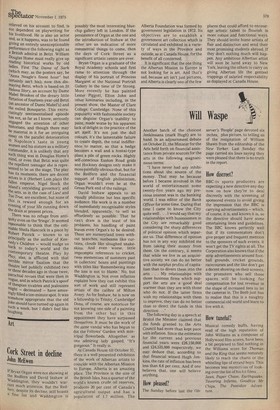Art
Cork Street in decline
John McEwen
If Bryan Organ were not showing at the Redfern and David Inshaw at Waddington, they wouldn't warrant much attention. But the Redfern, despite its decline, still boasts a fine list and Waddington is possibly the most interesting bluechip gallery left in London. If the persistence of Organ at the one and the introduction of Inshaw at the other are an indication of more commercial things to come, then the days of Cork Street as a significant artistic centre are over.
Bryan Organ is a graduate of the Royal Academy schools and first came to attention through the display of his portrait of Princess Margaret at the National Portrait Gallery in the time of Dr Strong. More recently he has painted Lester Piggott, Elton John and other luminaries including, in the present show, the Master of Clare College, Cambridge. None of this popularity with fashionable society can disguise Organ's inability to paint, made worse by his apparent lack of delight in the practice of the art itself. It's not just the dull colours, it's the lamentable failure to create depth, the total indifference to matter, so that a hedge becomes a wall and a hostal-type plant a pile of green rocks. Highly self-conscious Euston Road grids and Hockney designs only make it more painfully obvious that, but for the Redfern and the financial support of English philistinism, Organ wouldn't even be at the Green Park end of the railings.
David Inshaw appeals to an equally philistine but less specific audience. His work is in a number of immediately recognisable styles blended, apparently, to sell as effortlessly as possible. That he can't draw is the least of his problems, his handling of paint leaves even Organ's to be desired. There are nurseryland trees without branches, sunbeams like curtains, clouds like sloughed snakeskins. And even worse, little impromptu references to cricket, twee mementoes of summers past in collectors' boxes and paintings with titles like 'Remembering mine the loss is not to blame.' No, but Waddington is. Not even inflation explains how they can exhibit this sort of work and still represent artists of the calibre of Milton Avery. As for Inshaw, he is now on a fellowship to Trinity, Cambridge! Dons, of course, are notorious for not knowing one side of a painting from the other but in this appointment they have surpassed themselves. It must be the work of the same vandal who has begun to dot the Fellows' Garden with minicipal flowerbeds. Altogether, as one admiring lady gasped, "It's gorgeous." It really is.
At Canada House till October 31, there is a well presented exhibition of the work of Albertan artists to coincide with the Albertan Mission to Europe. Alberta is an amazing place. The Province is the size of the British Isles, has a quarter of the world's known crude oil reserves, produces 20 per cent of Canada's agricultural output and has a population of 1.7 million. The Alberta Foundation was formed by government legislation in 1972. Its objectives are to establish a government art collection which is circulated and exhibited in a variety of ways in the Province and outside, as at Canada House, for the benefit of all concerned.
It is significant that the one thing the Albertan Mission to Europe is not looking for is art. And that's sad, because art isn't just pictures, and Alberta is clearly one of the few places that could afford to encourage artistic talent to flourish in more robust and functional ways. They should invite home artists of flair and distinction and send their most promising students abroad. If they don't nothing much will happen. Any ambitious Albertan artist will soon be lured away to New York, leaving the others to carry on giving Albertan life the genteel trappings of salaried respectability as displayed at Canada House.
































 Previous page
Previous page